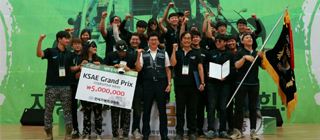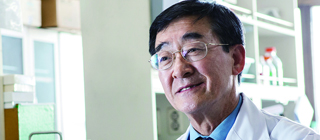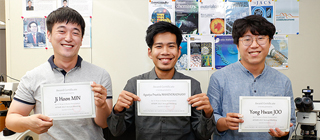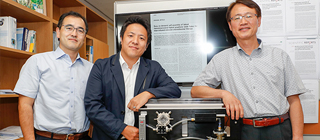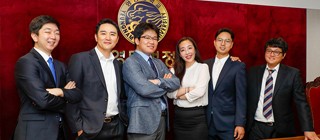-
College of Medicine Professor Choi Hyeok-jae’s research team joint research with the Marine Biodiversity Institute of Korea Microorganism that produces useful antibiotics with excellent antibacterial and antibiosis functions Finds optimal culturing conditions of microorganisms containing expensive antibacterial substances... Green light for the marine bio industry [September 13, 2017] <Professor Choi Hyeok-jae of the College of Medicine who discovered a new marine microorganism that produces useful antibacterial substances> Upon culturing and analyzing marine microorganisms found in the sedimentary soil on the coastlines of Jeju, the Ministry of Oceans and Fisheries announced that it had confirmed that it contained prodigiosin, a substance with excellent antibacterial and antibiosis functions. The research team of Professor Choi Hyeok-jae (left on photo) of the YU College of Medicine and the research team of Dr. Grace Choi of the Marine Biodiversity Institute of Korea discovered a new marine microorganism while exploring the sedimentary soil of the coastal regions in Gimnyeong, Jeju in March of last year. This substance was named Mabikibacter ruber after the name of the Marine Biodiversity Institute of Korea. The discovery of this microorganism was introduced globally by being published in the world’s most authoritative academic journal in the microorganism taxonomy sector, ‘IJSEM’ (International Journal of Systematic and Evolutionary Microbiology) on August 25, 2017. Mabikibacter ruber is a word combining MABIK from the National Marine Biodiversity Institute of Korea and bacteria (bacter). ‘Ruber’, which means red in Latin, was added as it has a red color while being cultured. Professor Choi said, “This strain was found by coincidence from marine sediment specimens that students on vacation collected.” He added, “This research was possible thanks to the students who are always interested in the surrounding nature.” In order to check the biological structure and whether it contains useful materials, the research team cultured Mabikibacter ruber for seven months in a medium (liquid or solid compound with nutrients needed to culture microorganisms, plants, tissues and cells) and extracted the strings and conducted chemical analysis. They discovered that it contained prodigiosin, an antibiotic with a red color. Prodigiosin is widely used as an antibacterial and antibiotic substance, while being effective against malaria. It is also being used for developing treatment for pancreatic cancer. There were also recent reports that prodigiosin suppresses the growth of borellia bacteria that causes lyme disease (infectious disease caused by a tick biting a person and spreading the borellia pathogenic bacteria in the human body causing diseases in various organs. The early symptoms are fevers, but when it advances, it can cause encephalitis, arrhythmia, myocarditis, etc.). It is thus expected that its value as an antibiotic will grow in the future. <College of Medicine Professor Choi Hyeok-jae’s research team> Professor Choi’s research team said, “In this study, we succeeded in the isolation and purification of prodigiosin, which was known to be very difficult, thus confirming the structure of prodigiosin that produces Mabikibacter ruber.” He added, “This substance is a prodigiosin derivative not available in the market, so its economic potential is enormous.” The research team found the optimal culturing conditions that can produce prodigiosin in mass amounts through the process of culturing Mabikibacter ruber, and is planning to develop mass production technologies through this. Currently, prodigiosin-type antibiotics are being traded at high prices in the pharmaceutical markets, and in the event that mass production technologies are developed by the research team and the technologies are transferred to relevant industry, it is expected to contribute significantly to the activation of the marine bio industry.
-
Proposed ‘smart rainroof bus’ and received good reviews for its ‘creativity, marketability, realistic possibility’ Improved capacities in majors through ‘C++ Camp’, ‘Embedded Camp’ and academic club activities during vacation Professors provided instructions at camps and clubs to raise satisfaction levels and capacities of students [September 12, 2017] <The YU Department of Information and Communication Engineering HOWTO Team awarded at the ‘4th Korean SW Convergence Hackathon Contest’.> (back row, left to right: Yang Hyun-gyu, Lee Yun-ho, Professor Kim Young-tak, front row left to right: Heo Jin-woo, Kim Ji-hyeon, Jang Ji-mo, Ha Dong-soo) Students from the YU Department of Information and Communication were awarded at the ‘4th Korean SW Conversion Hackathon Contest’. This contest, which is the nation’s largest SW convergence technology contest, was held for three days at the Kyungpook National University Global Plaza from the 31st of last month to September 2 hosted by the Ministry of Science and ICT and the National IT Promotion Agency. Hackathon is a word combining the two words of ‘hacking’ and ‘marathon’. Like a marathon, participants come up with ideas, engage in programming, and build creative works without resting for 42.195 hours. This contest was comprised of the three themes of ‘free topic’, ‘development of services for improving common life’, and utilization of public-data based water resources and development of flood prevention services’. A total of 296 people in 60 teams announced their unique ideas. In result, the ‘HOWTO’ team comprised of Heo Jin-woo (25), who graduated, and juniors Ha Dong-soo (24), Yang Hyun-gyu (24), Lee Yun-ho (22), Jang Ji-mo (22), and Kim Ji-hyun (20) of the YU Department of Information and Communication Engineering was awarded in the free topic sector. The idea proposed by the HOWTO team was the ‘Smart Rainroof Bus’. They designed functions in which wipers would activate automatically and a rain roof would operate automatically when opening and closing doors for passengers by detecting rain while the bus is operating. Their idea received good reviews in terms of creativity, marketability and realistic possibility. Team leader of HOWTO Heo Jin-woo said, “We thought about ways to improve user convenience by integrating IoT in buses that we use every day, and came up with this unique idea during our brainstorming session.” All of the students that were awarded were under the YU Department of Information and Communication Engineering’s HOWTO club (Advisor Kim Young-tak). The network programming academic club ‘HOWTO’ started in 2000 with 11 students, and gained popularity now having over 100 students participating in the club activities. They all said in unison, “The major capacity improvement camp operated during summer break by the department helped a lot in making it possible to come up with ideas, program, and configure prototypes in a short period of three days.” In addition to the regular curriculum, the students of the YU Department of Information and Communication participated in the ‘C++ Camp’ and ‘Embedded Camp’ during breaks to learn programming languages. Based on this, they applied it in hardware and improved their capacities through 3-4 week concentrated learning sessions. Despite these classes not being part of the regular curriculum, professors instructed the students to enhance student satisfaction levels, while also helping them to improve their capacities in their majors. Department of Information and Communication Engineering Professor Kim Young-tak, who is the advisor of the HOWTO club said, “It might be a bit difficult to follow classes in majors in the beginning,” and added, “If students participate in camps and programs on their majors during their vacation or through academic clubs aside from regular classes, it will help them gain more interest in studying their major.”
-
YU holds 'Saemaul Undong' training to next-generation leaders from eight countries in Asia and Africa "Want to integrate the Saemaul Undong for our national development... Want more Saemaul training opportunities" [August 28, 2017] <YU held Saemaul Undong training to 20 international students from Asia and Africa> Learning about the Saemaul Undong has become a new trend for international students from emerging countries studying in Korea. YU (President Sur Gil-soo) held Saemaul Undong training for international students enrolled at YU from August 21 to 25. This program, which was carried out with the support of the Saemaul Globalization Foundation' was organized to spread the meaning of the Saemaul globalization movement and the value of economic development to next-generation leaders of emerging countries, and to discover local experts for the successful operation of the Saemaul globalization project in the future. Unlike the past where Saemaul Undong training was offered as invitational training such as public employees and experts by the government, local autonomous groups, public institutes and corporation, this training was made up of the voluntary participation by 20 international students from the three African nations of Ethiopia, Tanzania and Ghana, and the five Asian countries of Uzbekistan, Vietnam, Nepal, China and Mongolia. This means that the global demand for the Saemaul Undong is not just for the older generation, but is spreading quickly to younger generations as well. The international students who participated in this training learned about the Saemaul Undong and Korea's economic development such as the principles and strategies of Saemaul Undong, characteristics of Korea's economic development, Saemaul Undong and rural development, forest greenification and erosion control and Saemaul Undong, and theories and practicality of leadership, etc. for five days. In addition, they had the opportunity to experience theoretical knowledge through visits to the Pohang Sabang Memorial Park, POSCO, and the Cheongdo Saemaul Undong Memorial Hall. Based on the knowledge and experience they acquired through this training, the students established action plans that could be integrated into the development of their nations and shared their opinions in order to improve their understanding on plans to apply the Saemaul Undong. <International students from Asia and Africa who visited the Cheongdo Saemaul Undong Memorial Hall> Chau Thi Thu Thuy (30, YU Graduate School of Korean Language and Literature PhD) from Vietnam who led the team said at the completion ceremony on the 25th, "I was able to see and experience a lot about the Saemaul Undong and Korea's economic development through this training," and added, "I would like to study hard at YU and go back to my home country to be contribute to the development of our country. I would like more opportunities for students to experience the Saemaul training for not only the older generation such as public officials, but also for students who will lead the future." YU International Development Center Director Park Seung-woo who oversaw this training said, "The changed perception of the people based on the understanding of the Saemaul spirit and the firm belief and continuous will of leaders played a big role in the success of the Saemaul Undong." He added, "I hope that this training will act as an opportunity for personal development and for continuously sharing the economic development experiences of Korea's Saemaul Undong. We should strive to mutually share the capacities and development experiences of individuals and countries." The YU International Development Cooperation Center is expected to become the top educational institute for the Saemaul Undong by taking the lead in the globalization of the Saemaul Undong from a mid- to long-term perspective by spreading the Saemaul Undong to students who wish to become next-generation leaders.
-
Choi Gyu-jin in the PhD course at the Department of Physics considerably increases OLED life and light efficiency Published in the recent issue of the global academic journal 'Advanced Materials' Increased possibility to apply in high resolution displays [September 4, 2017] <Choi Gyu-jin who is currently in the PhD course at the YU Department of Physics developed platform technologies that can significantly increase light efficiency of displays> Choi Gyu-jing (29, PhD) of the Department of Physics at YU developed platform technologies that can significantly improve the light efficiency of OLED (organic light emitting diode) display to receive attention from academic circles and industries. Choi substituted organic substances used for the hole transport layer of OLED elements with the secondary mineral material, molybdenum disulfide (MoS2) nanosheet to increase the life of materials. The hole transport layer was surface treated with ion beam and rubbing methods to acquire light with very high polarization. Recently, the importance of displays has grown greatly in the advanced electronic device sector, so Choi's research results are receiving more attention. Up until now, research on OLED polarized lighting, together with improving efficiency of displays, has been carried out continuously. Most studies adopted the method of strongly rubbing materials below the illuminating layer in the display to arrange the illuminating material molecules in one direction. <Mimetic diagram on surface treatment of the hole transport layer MoS2 nanosheets with rubbing method and ion beams to align the display lighting layer molecules> Choi said, "The polyimide material used in the past rubbing method is an insulator. Therefore, no matter how thin it is applied, it rapidly lowers the efficiency of materials. In addition, it is difficult to obtain clean lighting images due to surface scratches caused by strong rubbing." He went on saying, "In this study, MoS2 nanosheet was used for the hole transport layer, and obtained synergy effects by applying highly straight ion beams and rubbing methods simultaneously. Accordingly, by arranging the hole transport layer molecules in a straight line, it was possible to align the illuminating material molecules on top of it and thus enhance polarization by more than two times other studies. In particular, ion beams can help remove scratches caused by rubbing, and therefore, it enhanced the applicability of this in high resolution displays." Choi's research results will be published in the September issue in the world-acclaimed academic journal in the materials engineering sector <Advanced Materials>, impact factor (IF) 19.79. The corresponding author YU Professor of Physics Kwak Jin-seok (48) said, "The research results is valuable in not only that highly polarized illuminating materials that can deduce practical efficiency improvement of OLED and LCD displays were developed, but that it is the development of highly polarized light source that can be applied to various optical materials or optical devices and optical measuring instruments." Choi said, "My main field of research is optical materials." He added, "As I increased the possibility of application in the display industry through this study, I will additionally carry out research for improving the optical efficiency of display materials."
-
Department of Political Science & Diplomacy class of '05 alumnus Ahn Hyo-min joins third team of Daewon Theater Voice in the popular game 'League of Legend' Ahn Hyo-moon graduated from the YU Department of Political Science & Diplomacy, and after great efforts, he joined the Daewon Theater in the third team. He is currently active as a voice actor and played the voices of Zenyatta of 'Overwatch' and Remake Warwick of the 'League of Legend'. We met with Ahn Hyo-min and asked him about what efforts he made to become a voice actor and what was life like when he attended YU. We also asked for advice for students who dream of becoming voice actors. Why did you enroll at the YU Department of Political Science & Diplomacy? Up until high school, I had an ambitious dream to change this world. That is why I decided to go to the Department of Political Science & Diplomacy. At the time, this department did not have any hierarchy or other vices. That is why I loved the department so much. While preparing to become a voice actor and because of my ROTC activities, I was not able to participate as much in the department, but it was fun studying in this department as well. How did you prepare for becoming a voice actor while in college? I gained the dream of becoming a voice actor by coincidence in April after enrolling. So in May, I looked for voice acting academies. Most of these academies are in Seoul so it was difficult to find. I finally found a famous voice acting academy in Daegu. I went to the academy and took a test and then started attending this academy. My first problem was fixing my speaking habits. I was born and raised in Daegu so I had a strong Daegu accent. So I asked my teacher what I needed to do to change my accent. My teacher recommended that I go live in Seoul, but if I can't, I should try to speak with people from Seoul as much as possible. So I began online community activities. I talked with other aspiring voice actors that I got along with and went to Seoul once or twice a month. We spoke together and made amateur dubbing and really worked hard on fixing my dialect. I was able to fix my accent in a year and a half. In my senior year, I attended an academy in Seoul. After classes and finishing ROTC training every Monday and Friday, I took the KTX and went straight to Seoul. I spent a year going to classes on Friday night and Saturday and returning to Daegu. What is the most memorial thing that happened while in college? There was something more special than others. When people introduce their selves for presentations, they would usually say, "Hello, I am so-and-so and in so-and-so year," but I would add that I am preparing to become a voice actor. For example, I would say, "Hello I am Ahn Hyo Min at the Department of Political Science & Diplomacy year of '05 and I am an aspiring voice actor," and then I would do a bit of voice acting. At the time, I would imitate the narration of Mureuppak Dosa. By doing so I learned to become bolder. Voice actors have to act with their voice in front of many people so they need to be really bold. I worked hard since my college years to improve this area. You were picked for the third team of the Daewon Broadcasting Voice Actor Theater. What was the process up until passing? They only choose male voice actors who completed their military service, so after being discharged from the military, I spent a month at home resting and then went to Seoul. I attended an academy in Seoul. I completed the voice actor course at the KBS Academy and received training from Mrs. Jung Mi-sook, who was the voice actor for Nami in the animation <One Piece>. In addition, I managed an online internet cafe on Naver called Voice Maru for seven years and interacted with many people and held study sessions. I was finally able to pass after a long time of preparation. According to one media, it said that acting Remake Warwick in the game 'League of Legend' is one of the three hardest characters. Why is that so? It takes a lot physically. Remake Warwick is a crazy wolf character and requires a really rough voice. It was had having to yell a lot. Monsters and villains are usually big in size so the voice also has to be loud. So it took a lot on the throat, and when recording continuously, it put my throat in poor condition. How did you get to play the hero Zenyatta in 'Overwatch'? Blizzard picked me. It was not cast by application, and instead Blizzard would look at various works and chose the voice actors. That is how I got to play Zenyatta. What did you like the most about Zenyatta? Zenyatta is a robot monk warrior that transcended everything. I usually played roles of hurting and bothering nice characters and yelling all the time. On the other hand, Zenyatta was really new to me. It was a first time for me. I really love Zenyatta as a player of Overwatch. What efforts are needed as a voice actor? You need to identify the character and tone of your character. You should analyze it and then make efforts to maximize it. If you play the voice of a character, you should analyze that character's background, behavior, personality and its relationship with other characters. Such efforts include watching animations, movies and books in which similar characters appear. And always practicing speech is absolutely essential. Lastly, do you have any tips that you would like to give to aspiring voice actors? You need to do a lot of imitation. Some people say that imitating is the short-cut for gaining bad habits. But I do not agree. You need to imitate others a lot to improve. You need to see a lot, imitate a lot, and practice a lot. You can thus create your own database through this. As people who used writing practice notebooks as children may know, there are dotted lines or shadowed areas to trace across to write letters. You need to have a model to be able to look and follow. Without that, it will be difficult to be able to understand characters.
-
School of Mechanical Engineering Club ‘YUSAE’ wins 'overall best' repeatedly in large-scale contests such as in Gunsan Continuously participated in domestic and foreign contests such as in the US, England and Japan to gain experience since 2000 Established College of Mechanical and IT Engineering and the Department of Automotive Engineering in preparation of the 4th industrial revolution [August 22, 2017] <The YU self-made automobile club 'YUSAE' who won the ‘2017 KSAE College Student Self-Made Automobile Contest’> The YU School of Mechanical Engineering and the Department of Automotive Engineering's self-made automobile club 'YUSAE' team swept large-scale college self-made automobile contests this year. The YU YUSAE team won the grand prix at the '2017 KSAE College Student Self-Made Automobile Contest' that recently ended at the Saemangeum Gunsan Automobile Race Track. The YUSAE team took first place in the BAJA section joined by a total of 103 teams and won the Minister of Trade, Industry and Energy Award, a cash prize of 5 million won, and the winner's flag. The YUSAE team received high scores in various areas such as automobile test, auto-cross, endurance etc. In particular, in the last endurance race, it caught up 100 meters in the final lap of 35 laps to Hanbat University, and passed the finish line, creating the highlight of this event. The YUSAE team also showed unparalleled performance at the '2017 PRIME Baja SAE' at YU last month taking first place, making this second overall victory. This is the first time for an automobile designed and produced by the same university to win two large-scale college student self-made automobile contests in the same year. <'YUSAE' in an endurance race at the ‘2017 KSAE College Student Self-made Automobile Contest’> Cha Joon-ho (25, School of Mechanical Engineering, senior) of the YUSAE team said, "Team members shared opinions for ech part such as suspension, engine and frame in the automobile design stage and cooperated to make perfect designs. In the production stage, we minimize the range of error with the design to produce the automobile, which I think led to the great results." YUSAE, which was the first team in Korea to participate in the US Baja Contest in 2000, participated in the US Baja 14 times and also participated in the Formula contest of England, Japan and Australia, and the 'Shell Low Fuel Consumption Contest' of Malaysia to enhance their capacities in various domestic and foreign self-made automobile contests. The YUSAE team took three overall wins and second place one time in the past four years at the 'Baja SAE KOREA', and also took the gold medal at the '2016 KSAE Formula Contest', thereby solidifying its position as one of the strongest teams for self-made automobile contests for college students. <'YUSAE' that took overall first place at the ‘2017 Baja SAE KOREA’> Such achievements were not made overnight. This was the fruit of the ceaseless efforts of professors and students. YU ewas the first to host the Baja SAE in Korea in 1996. Professors worked hard to be able to host the international event and won sponsorships from automobile companies, and has thus successfully held the Baja SAE successfully for the 22nd year. Students have operated the self-made automobile club since 1992 to improve their practical capacities by producing automobiles based on the theories they learned in their regular courses. It is expected that the potentials of YU professors and students in the Department of Automotive Engineering will gain a synergy effect by linking up with the Ministry of Education's 'Program for Industrial Needs - Matched Education (PRIME)' being pursued by YU. YU separated the majors of electric, electronics, computer, information communication, and mechanical in its college of engineering in the past to establish the 'College of Mechanical and IT Engineering', and also established the Department of Automotive Engineering in this college and accepted its first freshmen class. Accordingly, it is expected that it will lead the fostering of human resources and develop the future-oriented automobile industry such as self-driving vehicles and electric vehicles, which were pointed out as prospective industries that will create future industrial value. <Car parade of the '2017 Baja SAE Korea' held at YU> YU Department of Automotive Engineering Dean Hwang Pyeong said, "Simply making a department does not give competitiveness. Hosting the international self-made automobile contests for 22 years and concentrating on the fostering of clubs over a long period of time so that students can assertively learn is the knowhow of YU. No university will be able to catch up in a short period of time." He added, "By operating the department together with the Ministry of Education's PRIME program from last year, it is expected that there will be more active industry-academic cooperation as well."
-
Chair Professor Jang Hyun-wook (College of Pharmacy) becomes first to explain the allergy suppression mechanism of the longevity gene ‘Sirt1’ Published on online version of Nature's sister journal ‘Scientific Report’ [August 8, 2017] YU Chair Professor Jang Hyun-wook (College of Pharmacy) became the first to explain that the 'Sirt1' gene, which is also known as the longevity gene, suppresses allergic reactions. In 2013 and 2014, Professor Jang scientifically revealed that by artificially activating 'AMPK (AMP-activated protein kinase)', which is a sensor protein to maintain the homeostasis of body energy, it is possible to not only treat metabolism-related diseases such as type 2 diabetes, but also allergy-related diseases as well. The research results at the time received huge attention from academic circles in that is provided the cornerstone for developing new drugs that can treat metabolism-related diseases and allergy-related diseases simultaneously. Upon continuously conducting allergic reaction adjustment research through the interaction of proteins within cells, Professor Jang confirmed through his research that 'Sirt1' suppresses allergic reactions. 'Sirt1' is a protein that detects changes in bio energy like 'AMPK' and it is an enzyme with deacetylation activation. 'Sirt1' is known to have effects for extending longevity by suppressing the death of old cells. Its suppression of calories reduce the risk of chronic diseases, and it is known to be one of the best ways to prolong life. Its effects have been proven time and again in various life forms through scientific experiments. The core adjusting factor for this is the 'Sirt1' gene. Professor Jang said, "'Mast cell', which is a key cell that causes allergic reactions, suppresses the activation of obesity cells by having 'Sirt1' form a compound with 'LKB1' and 'AMPK' when there are no antigen-antibody stimulation. However, dissociation occurs in this compound when stimulated, and instead, the dephosphorylation enzyme 'PTP1B' forms a compound with 'Syk kinase' to generate mediators that cause allergies to promote allergic reactions, which was confirmed through this research." He also added, "Through this process, it was confirmed for the first time through cell and animal tests that 'Sirt1' and 'PTP1B' can adjust allergic reactions through mutual reverse action." The results of this study are significant in that it provided important base data that pharmacologically 'Sirt1 activation' or 'PTP1B suppression' can be used for developing new medicine that improve not only allergic diseases but also metabolism-related diseases. Professor Jang announced his future research plans stating, "In addition to the Sirt1, which is the adjusting protein of AMPK, I will continue research on allergic reaction adjustment mechanism research through interaction with new adjusting proteins and research on finding ‘Sirt1-LKB1-AMPK’ route activators." This study was carried out as the 'basic research lab support project (BRL)' supported by the Ministry of Science, ICT and Future Planning and the National Research Foundation. The research results were published in the sister journal of Nature, 'Scientific Reports' online version (July 25, 2017).
-
Three bachelors/masters at Professor Koh Young-gun's research lab Swept '1st, 2nd and 3rd place in the poster awards' at the 'APSMR-2017' international academic conference in the materials sector Research power synergy effects through sharing and collaboration in research among undergraduate and graduate school students [August 16, 2017] <YU School of Materials Science and Engineering students who swept first, second and third place in the best poster awards at the ‘2017 APSMR’> (From left to right: Min Ji-hoon, Mahendradhany, Joo Yong-hwan) YU students swept the thesis awards at a recently opened international academic conference in the materials sector. At the '2017 APSMR (Asia Pacific Society for Materials Research)' held from July 27 to 30, YU School of Materials Science and Engineering undergraduate and graduate school students under the YU School of Materials Science and Engineering Professor Koh Young-gun (41) research lab took home first, second and third places in the best poster awards section. It is very rare for students from the same research lab to sweep first, second and third places in a globally acclaimed international academic conference. This shows that the research prowess of the YU School of Materials Science and Engineering is at a world-class level. At this international academic conference, over 200 researchers from Japan, China, Taiwan, etc. participated to present 120 research results. Mahendradhany Agasty (24, second term of master's degree program) enrolled at the YU Graduate School of Materials Science and Engineering) took first place, followed by Min Ji-hoon (26, first term of master's degree program) for second, and Joo Yong-hwan (25) who is currently a senior for third place. They presented the latest research results for 'giga steel heat treating technologies', 'bio-activating surface treating technologies', and 'light metal plastic working technologies'. The research results were published in the internationally respected academic journals 'Scientific Reports;, Physical Chemistry Chemical Physics, and Langmuir. Advising Professor Koh Young-gun said, "The awards received were achieved based on the materials application technologies of heat treating, surface treating and plastic working, which is the backbone for the competitiveness of next-generation automobile materials industries." He added, "The technologies are highly applicable for the automobile materials industry, which is a key industry in the region, and can thus contribute in creating high values through materials innovations." Min Ji-hoon, who was awarded at this conference, also took first place in the poster session of the 'IPMC 2016 (International Process Metallurgy Conference 2016)', which is an international academic conference in the metals field held in Bandung, Indonesia last year while he was a senior as an undergraduate. 'IPMC' is an event where master's and PhD-level researchers from around the world present their research results, and Mr. Min thus received huge attention after taking first place as an undergraduate. Min Ji-hoon said, "Our research lab's culture is one of cooperating and sharing research from undergraduate levels to graduate levels. Focusing on research with our professor and graduate school students ever since my undergraduate school years led to improved research capacities and great outcomes." <School of Materials Science and Engineering Professor Koh Young-gun (fourth from top left) research lab students> Meanwhile, Professor Koh's research team has been cultivating award-winners of various international academic conferences such as the poster awards at 'Green 2015' in Taiwan, poster session award at the 'IPMC 2016' held in Indonesia, and the outstanding poster presentation award at the 'Korean Institute of Metals and Materials' in the past two years.
-
Professors Byun Jung-hoon (Mechanical Engineering)-Kim Jong-oh and Yong Cheol-soon (Pharmacology) reaps outcome of inter-disciplinary convergence research First to develop 'aerosol continuous process', which is a new technology that can be applied to the manufacturing of multi-functional nan-drugs Published in the latest issue of Nature's sister journal 'NPG Asia Materials' [August 17, 2017] <YU research team that developed new technologies for manufacturing drugs through inter-disciplinary (mechanical engineering-pharmacology) integrated research> (From left to right: College of Pharmacy Professor Kim Jong-oh, School of Mechanical Engineering Byun Jung-hoon, College of Pharmacy Yong Cheol-soon, bottom - aerosol continuous process device) YU is receiving attention from academic circles by developing new drug manufacturing technologies through inter-disciplinary (mechanical engineering-pharmacology) integrated research. YU School of Mechanical Engineering Professor Byun Jung-hoon (38) and College of Pharmacy Professors Kim Jong-oh (42) and Yong Cheol-soon (61) conducted collaborative research and became the first to develop the continue process of aerosol (small solid or liquid particles suspended in the air) to manufacture nano-drugs in an on-demand method (manufacturing necessary materials upon the need of users). The YU research team presented the research results of using the developed aerosol continuous process to manufacture nano-drugs (hybrid nano graphene oxide) needed for near infrared ray-induced heated chemotherapy for effective cancer treatment. The research team explained, "The developed technology is a new platform technology that can be applied in a wide range of various multi-functional nano-drug manufacturing," and added, "It can be used as an alternative to the existing complex liquid chemical process, and therefore, it can be applied as a new process technology in the pharmaceutical industry, and furthermore, be applied for customized treatment based on the on-demand method." The research results were published in the latest edition (August 4, 2017) of the world-acclaimed academic journal <NPG Asia Materials> (Impact factor (IF) 9.157) under the title 'Easy on-demand self-assembly of lateral nanodimensional hybrid graphene oxide flakes for near-infrared-induced chemothermal therapy’. Professor Byun Jung-hoon said, "The achievement of this study was the development of platform technologies that can create new additional values for the industry as a joint research combining mechanical engineering and pharmacology." He added, "We are currently concentrating on cooperative research with research teams in the pharmacology sector in order to provide the cornerstone for research and to create values through various bio-medical applications of aerosol. In addition to collaborative research within Korea, we are also engaged in international joint research with the US, Germany and others."
-
Praised for identifying the point of the controversy and high comprehension level and rational defense for the logic of both sides Kang Chang-oh (9th class) won MVP with the best defense plead "I wish to realize legalism and manifest national interests as an attorney" [August 21, 2017] <'Wonyung Muae' team of YU Law School that won the grand prize at the '2nd Mock Administrative Court Contest> (From left to right: Jang Jae-ik, Kang Chang-oh, Jung Gi-yeon, Ji Ja-ram, Jin Hyeong-wook, Baek Chang-ho) The YU Law School (Dean Kim Chang-hee) won the grand prize at the recently held mock administrative court contest. The winning team was the 'Wonyung Muae' team comprised of first-year law school students of the 9th class - Kang Chang-oh (41), Baek Chang-ho (37), Jung Gi-yeon (34), Jang Jae-ik (31), Jin Hyeong-wook (33), and Ji Ja-ram (31). Kang Chang-oh also received the MVP award given to the most outstanding participant in the contest. This was the second time that this contest was held and it was hosted by the Anti-Corruption and Civil Rights Commission and co-sponsored by the Korean Bar Association, Korea Legal Aid Corporation, Korean Association of Law Schools, and the Law Times. In this contest, which was comprised of preliminary reviews of the trial outline and the main mock administrative court contest, a total of 112 people from 16 teams from 13 law schools around the nation competed. After preliminary reviews, a total of eight teams from seven law schools including YU, Korea University, Seoul National University and Sungkyunkwan University competed in the final contest. The theme of the final contest held at the courtroom of the Sejong Central Administrative Judgment Commission on the 20th of last month was the 'Appeal to Retract Suspension of Doctor Licenses'. The participants randomly picked to defend the 'consulting' team to accept that appeal of the claimant to support them and the 'dismissal team' that judged the administrative disposition to be lawful and feasible. The two sides debated fiercely over the issue. The YU team made their defense for 'dismissal' in both trials against other teams. All of the team members received good reviews from judges due to their high level of comprehension on the issues without being geared too much to one side, as well as the logic for both sides, and made their defense in a rational manner. In particular, the YU Law School stood out even more as they participated with the least number of team members at six people. The team members said, "It helped a lot to not lean towards any single logic of consulting and dismissal, while being sufficiently prepared for the issue and taking on a rational approach for both logics." The added, "All of the team members had deep understanding for the legal principles for both dismissal and consulting, and we changed roles and held numerous rehearsals, making it possible for us to react logically regardless of whether we were on the side of dismissal or consulting during the contest." Kang Chang-oh, who won the MVP at this contest said, "During the contest, I realized that there is a big difference in writing what I learned in textbooks with expressing it in words by applying it in the field. During the process of making the defense by applying it in the field, I thought about carefully the positions of the opposing sides and made my approach carefully, making it possible to perceive the issue with a balanced and rational perspective without leaning too much to any single side." He added, "With this award that I did not expect, I have become a lot more confident as well. I believe that this short experience will be a valuable asset for me in the future as a lawyer." They said, "While we are still lacking in skills as future lawyers, Dean Kim Chang-hee and Former Dean Keum Tae-hwan, as well as the other law school professors' advice and encouragement were huge help. In particular, the professors of administrative law helped us with writing our paper and preparing our defense, and their help is what led us to receive this award." They added, "Our team name 'Wonyung Muae' is a Buddhist terminology and it means 'coming together to make harmony'. While we expressed opinions from different angles and made legal arguments in court, we would like to contribute in creating harmony with the common goal of realizing legalism and promoting national interests."
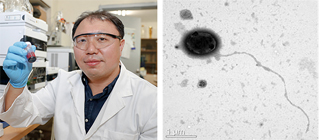
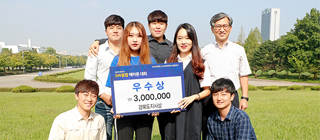
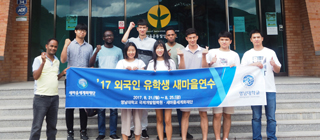
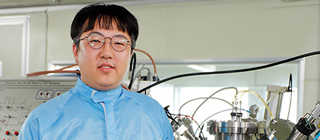
![[Person Who Walked Cheonmaro] Voice Actor Ahn Hyo-moon](/app/board/attach/image/thumb_33294_1504682070000.do)
